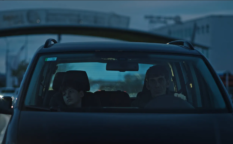Review: Dick Johnson Is Dead (2020)

We are dying. We all are. From the moment of birth, life takes a more or less natural progressions that inevitably ends with death. Some of them are sudden, while the others expected. Some of us are dying slowly, almost imperceptibly, and some are approaching the final end in a more hastily manner. Dick Johnson, the protagonist and the subject of Kirsten Johnson’s documentary is not dead yet, but he is heading down on a one-way road to be so in Dick Johnson Is Dead.
Kirsten Johnson has dealt with death before, most notably in her previous feature-length documentary, the lauded and awarded Cameraperson (2016) that ended up on a number of the decade’s top-lists in the documentary competition. Cameraperson was an essay on a pretty much unrelated topic of seeing the world through the lens of a camera (before directing documentaries, Kirsten Johnson made her name as a cinematographer that worked with many of the big guns of the American documentary scene), and death in it was due to Johnson’s mother dying slowly of Alzheimer’s. Ten years later, her father and, as she puts it, best friend is facing the similar music, so she decided to follow him around as both of them are getting prepared for the worst.
There are several usual ways to treat the subject of death in the documentary cinema. It can be very personal as the filmmaker chronicles someone’s struggle with the disease and the ups and downs when the outcome is quite predictable. The other approach is essayistic, with a philosophical distance: death is being examined as a concept, without any concrete person in mind. Death can be also a part of the statistics in the documentaries about history, wars, crime or some other destructive events. The path Kirsten Johnson takes is sincere, fresh, new and unexplored, so the end result is a film that is quite unique and also impossible to replicate.
On the most plain aspect of the film, Kirsten Johnson studies Dick’s life getting out of the control. He used to be a psychiatrist who lost his wife to the same condition he is suffering from, so he is aware of what is happening to him on a certain level, and what is going to happen further down the road. What started as a case of forgetfulness (like double-booking his patients and writing them wrong prescriptions) escalated to a more dangerous territory, like high-speed driving through a construction site. He had to close his practice and move with his daughter in New York, which also means selling his car, not driving any more and subsequently losing some of his freedom. Dick seems to be doing fine with that. He enjoys eating chocolate, spending time with Kirsten and his grand-children, and he also goes to visit an old flame of his. He describes his position as her kid brother whose job is to tag along.
Actually, he is more than happy to do more than that, to play along withthe idea of his daughter to “kill him off” in a number of scenarios that vary in their probability and suddenness. An AC unit falls on him, he falls down a staircase, he has a heart attack, he gets hit by a car or by a plank with a rusty nail in it. Some of those scenes come as a surprise for the viewers, the others are elaborated on the meta level, since Kirsten has even hired a stuntman to act as Dick’s body double in more dangerous acts. There is also a bit of a (visible) manipulation, as she decides to include one of the meta-scenes in which she pushes him to take one more repetition when he is tired.
But the mental and the physical are not the only aspects of someone’s death. There are also social and religious elements to it that are also staged in an off-beat manner not to dissimilar to the killing-off stunts. We are served visions of heaven Dick imagines and Kirsten stages according to them, which could be seen as sacrilege in his Seventh Day Adventist denomination, and a fake funeral that Dick attends in his own coffin (there is even a rehearsal for it, because why not) that has some emotional consequences to one of his close friends who melts down while reading the eulogy.
Kirsten Johnson manages to blend it all into an uneven, strange, sometimes manipulative, sometimes speculative mixture of hard reality, filmmaking mechanics and fantasy. The three worlds are coded with their own aesthetics, as she employs the hand-held camerawork and engages in conversations from her off-screen position in the realistic, observational scenes, while the fantastic ones are staged to the maximum, usually ending with a widening shot that reveals the filmmaking crew, equipment and props. In the end, Dick Johnson Is Dead feels unique and sincere, rather than manipulative, as it is not that hard to “buy” it as the filmmaker’s personal imagination and (probably futile) preparation for the loss of her father.
Dick Johnson Is Dead had started its festival tour after triumphing at the national documentary competition of Sundance, but it was soon cut short due to outbreak aof Covid-19 and the subsequent cancellations of festivals and public events. Luckily, it has found its place on Netflix and continued reaping the awards from various, mostly American, film critic circles which might prove to be significant in the coming awards season. So far, the film has the status of a frontrunner which earns it a spot in our Award Ticker section.
Runtime: 89’
Country: USA
Language: English
Directed by: Kirsten Johnson
Written by: Kirsten Johnson, Nels Bangerter
Cinematography by: Kirsten Johnson, John Foster
Editing by: Nels Bangerter
Music by: Syzygys
Production design by: Nathan Fisher
Costume design by: William Mellette
Make-up by: Tara Carrara, Dawn Tunnell
Colourist: Seth Ricart
Assistant director: Kate Branom
Produced by: Kirsten Johnson, Katy Chevigny, Marilyn Ness
Executive producer: Megan Ellison
Production company: Big Mouth Productions
Distribution by: Netflix

















Oscar-Woche: Meine kleine Preisverleihung – Die „Craftis“ – CraftingLove – MovieBlog
2021-04-20 @ 17:18
[…] Copyright http://ubiquarian.net/2021/01/review-dick-johnson-is-dead-2020/ […]